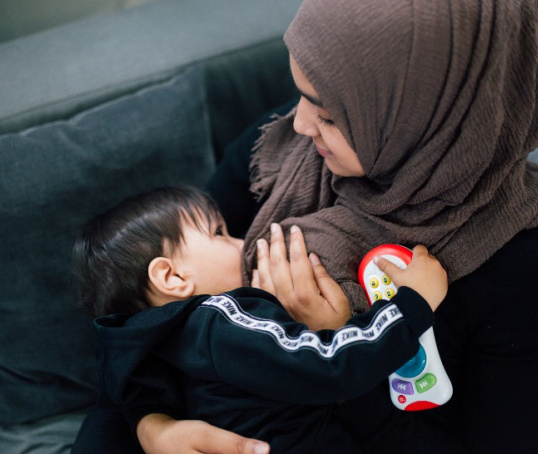Here we explore the theory and practice of attachment parenting so you can see whether this style – or elements of it – might be right for you.
Wondering what parenting style will suit you? We’ve identified four of the most popular in a mini-series. This article covers attachment/child-centred parenting. Other approaches to also explore are: parent-led parenting, positive parenting and mindful parenting.
Adopting a style, or mixing and matching
Some parents will choose to follow a style to the letter. And others are more in the flex-camp. Our mini-series explores two ends of the styles spectrum (attachment and parent-led) and two others that complement these and may be less divisive (positive and mindful).
Some parents find it helpful to work to someone else’s rules and others don’t. Chances are you might end up somewhere in the middle, learning and implementing techniques as you go. See how your style evolves as you do.
So what exactly is attachment parenting?
In a nutshell, attachment parenting is about constant physical closeness and being very responsive to the baby. This includes carrying your baby in a sling or carrier, co-sleeping and long-term breastfeeding. The thinking is that physical touch helps parents to nurture the bond with their baby and respond to their needs (Sears, 2020).
It’s easy to get attachment parenting confused with attachment theory. Attachment theory states that a child’s early experiences sets a blueprint for how their relationships are formed long-term (Bowlby, 1952). According to attachment theory, we are all securely or insecurely attached, which starts with how we were parented, and informs how we interact in the world as adults (VeryWellMind, 2020). Parents who are aware of attachment theory help their baby to regulate their emotions (Hans, 2016).
Attachment parenting is informed by attachment theory. Paediatrician William Sears and his wife Martha formally developed the method of attachment parenting into a parenting style in the 1980s. Their idea was that a secure parent–child attachment, achieved by being sensitive and responsive, paves the way for their independence and secure relationships as an adult (Sears and Sears, 2001).
For many parents, this approach feels natural and intuitive. Official organisations API (Attachment Parenting International) and APUK (Attachment Parenting UK) have been set up, as well as countless other support groups.
The main features of this approach are:
- frequently holding your baby close (e.g. carrying your baby in a sling or carrier)
- encouraging nurturing touch (skin-to-skin and kangaroo care)
- breastfeeding on demand
- avoiding strictly-timed, adult-imposed feeding schedules
- being responsive to a baby’s cries
- being sensitive and responsive to a child's emotions (e.g. helping them cope with night-time fears)
- co-sleeping (infants in the same room as parents, or young siblings sharing a room).
(Sears and Sears, 2001; Miller and Commons, 2010)
Advocates of attachment parenting tend to stress that it isn’t necessary for parents to follow all of the practices they outline. There is no checklist, just illustrations of ways that parents can strive to be sensitive and responsive (Sears and Sears, 2001). API states that parents should ‘take what works and leave the rest’ (API, 2019). And this makes sense, as we all know there is no one-size-fits-all when it comes to little ones and their needs.
What’s the evidence that these methods lead to secure attachment?
Many elements of responsive parenting are backed by evidence that suggests that they lead to secure attachments. These elements include:
- engaging in quality communication
- sensitivity during play
- emotional sensitivity and availability
- showing sympathy to your child’s upset
- keeping them close (e.g. carrying your baby in a sling or carrier).
(Anisfeld et al, 1990; Ziv et al, 2000; Meins et al, 2001; Koren-Karie et al, 2002; McElwain and Booth-Laforce, 2006)
Why is forming a secure attachment beneficial?
The thinking is that by being highly responsive, you prevent your baby experiencing potentially overwhelming negative emotions like distress, fear and anger (Miller and Commons, 2010). This, according to studies, can have a number of benefits.
Help with emotional resilience and regulation
Attachment security has been shown to buffer the effects of parent stress on a child, reducing the likelihood of emotional and behavioural problems as a result of these stresses (Tharner et al, 2012). It helps them regulate their emotions more effectively (Davidov and Grusec, 1996; Kerns et al 2007; Miller and Commons, 2010; Hans, 2016; Cooke et al, 2019).
The confidence to explore on their own
Children with a secure attachment have been found to feel confident exploring the world on their own. This is because they trust their parents to be there for them (Mercer, 2006). Babies are also less likely to be fearful if their parents show higher levels of emotional sensitivity and responsiveness towards them (Gartstein et al, 2017).
Fewer behaviour problems
Studies show that children who are securely attached to their parents are less likely to develop behavioural problems (Madigan et al, 2015). Some other studies suggest the children of responsive mothers are less likely to have behavioural problems (Kok et al, 2013).
Increased cognitive development (aka brain power)
Securely attached toddlers and children may score better in intelligence tests. They also score better at communication, cognitive engagement and the desire to learn new skills (Ding et al, 2014).
Better stress response, linked to touch
Research has shown babies who received skin-to-skin contact in the first weeks of life had developed, by age 10, more healthy stress response mechanisms, had better sleep patterns, and better cognitive control (Feldman et al, 2014). Caressing babies who are at high risk of developing abnormal stress responses has also been shown to prevent these responses developing (Sharp et al, 2012).
Why has this method been criticised?
Attachment parenting has its critics for several reasons:
- It can be seen as a rigid set of practices to follow.
- Some people feel it implies other forms of parenting don’t lead to secure attachments between parent and child.
- Some people feel that other parts of the parent’s life like relationships, financial security and the personal choices of the parent are treated as less important. They might feel it could lead to personal, financial and health problems for the whole family.
- People might think the ideas and behaviours have the potential to make parents feel inadequate if they can’t be stuck to. Parents could feel like they’re parenting badly.
- Some people may find the concepts complicated and some parents may feel criticised or more anxious.
(Hans, 2016)
This approach does face potential issues. Women who need to return to work, and are not supported by a partner who will attachment parent, can feel inadequate as parents. Attachment parenting can be viewed as a privilege, as both single mothers and many families may need to go back to work to survive.
Where a couple are not sharing the load equally, it can also be hard on the relationship.
Choosing your parenting style
As with any big decision, have a good think and approach everything you read and hear with a healthy dose of realism. It isn’t always possible to respond to your baby every time they cry and you shouldn't put unrealistic expectations on yourself. You can choose to be responsive without following the advice of a theory to the letter.
This page was last reviewed in February 2022.
Further information
For more advice and ideas when it comes to all aspects of parenting, see our other articles on parenting styles.
Our support line offers practical and emotional support with feeding your baby and general enquiries for parents, members and volunteers: 0300 330 0700.
You might find attending one of NCT's New Baby groups helpful as they give you the opportunity to explore different approaches to important parenting issues with a qualified group leader and other new parents in your area.
Make friends with other parents-to-be and new parents in your local area for support and friendship by seeing what NCT activities are happening nearby.
Anisfeld E, Casper V, Nozyce M, Cunningham N. (1990) Does infant carrying promote attachment? An experimental study of the effects of increased physical contact on the development of attachment. Child Dev. 61(5):1617-1627. Available at: http://dx.doi.org/10.1111/j.1467-8624.1990.tb02888.x
API. (2019) Attachment parenting. Available at: http://www.attachmentparenting.org/ [Accessed 24th February 2022]
Bowlby J. (1952) Maternal care and mental health. World Health Organization, Geneva. Available at: http://apps.who.int/iris/bitstream/10665/40724/1/WHO_ MONO_2_(part1).pdf [Accessed 24th February 2022]
Cooke JE, Kochendorfer LB, Stuart-Parrigon KL, Koehn AJ, Kerns KA. (2019) Parent-child attachment and children's experience and regulation of emotion: A meta-analytic review. Emotion.19(6):1103-1126. Available at: http://dx.doi.org/10.1037/emo0000504.
Davidov M, Grusec JE. (2006) Untangling the links of parental responsiveness to distress and warmth to child outcomes. Child Dev. 77(1):44-58. Available at: http://dx.doi.org/10.1111/j.1467-8624.2006.00855.x
Ding YH, Xu X, Wang ZY, Li HR, Wang WP. (2014) The relation of infant attachment to attachment and cognitive and behavioural outcomes in early childhood. Early Hum Dev. 90(9):459-64. Available at: http://dx.doi.org/10.1016/j.earlhumdev.2014.06.004
Feldman R, Rosenthal Z, Eidelman AI. (2014) Maternal-preterm skin-to-skin contact enhances child physiologic organization and cognitive control across the first 10 years of life. Biol Psychiatry. 75(1):56-64. Available at: http://dx.doi.org/10.1016/j.earlhumdev.2014.06.004
Gartstein MA, Hancock GR, Iverson SL. (2017) Positive affectivity and fear trajectories in infancy: contributions of mother-child interaction factors. Child Dev. 89(5):1519-1534. Available at: http://dx.doi.org/10.1111/cdev.12843
Hans H. (2016) Introducing parents to attachment theory. Perspective, Issue 32. Available at: https://www.nct.org.uk/sites/default/files/related_documents/Hans%20Int…; [Accessed 24th February 2022]
Kerns KA, Abraham MM, Schlegelmilch A, Morgan TA. (2007) Mother-child attachment in later middle childhood: assessment approaches and associations with mood and emotion regulation. Attach Hum Dev. 9(1):33-53. Available at: http://dx.doi.org/10.1080/14616730601151441
Kok R, Lucassen N, Bakermans-Kranenburg MJ, van Ijzendoorn MH, Ghassabian A, Roza SJ, et al. (2013) Parenting, corpus callosum, and executive function in preschool children. Child Neuropsychol. 20(5):583-606. Available at: http://dx.doi.org/10.1080/09297049.2013.832741
Koren-Karie N, Oppenheim D, Dolev S, Sher E, Etzion-Carasso A. (2002) Mothers' insightfulness regarding their infants' internal experience: relations with maternal sensitivity and infant attachment. Dev Psychol. 38(4):534-42. Available at: http://dx.doi.org/10.1037//0012-1649.38.4.534
Madigan S, Brumariu LE, Villani V, Atkinson L, Lyons-Ruth K. (2015) Representational and questionnaire measures of attachment: a meta-analysis of relations to child internalizing and externalizing problems. Psychol Bull. 142(4):367-399. Available at: http://dx.doi.org/10.1037/bul0000029
McElwain NL, Booth-Laforce C. (2006) Maternal sensitivity to infant distress and nondistress as predictors of infant-mother attachment security. J Fam Psychol. 20(2):247-255. Available at: http://dx.doi.org/10.1037/0893-3200.20.2.247
Meins E, Fernyhough C, Fradley E, Tuckey M. (2001) Rethinking maternal sensitivity: mothers’ comments on infants’ mental processes predict security of attachment at 12 months. J Child Psychol Psychiatry. 42(5):637-648. Available at: https://doi.org/10.1111/1469-7610.00759
Mercer J. (2006) Understanding Attachment: Parenting, Child Care, and Emotional Development. Praeger Publishers Inc, Westport, CT.
Miller PM, Commons ML. (2010) The benefits of attachment parenting for infants and children: A behavioral developmental view. Behav Dev Bull. 16(1):1-14. Available at: http://dx.doi.org/10.1037/h0100514
Sharp H, Pickles A, Meaney M, Marshall K, Tibu F, Hill J. (2012) Frequency of infant stroking reported by mothers moderates the effect of prenatal depression on infant behavioural and physiological outcomes. PLoS ONE. 7(10):e45446. Available at: http://dx.doi.org/10.1371/journal.pone.0045446
Sears W. (2020) Attachment parenting. Available at: https://www.askdrsears.com/topics/parenting/attachment-parenting/ [Accessed 23rd February 2022]
Sears W, Sears M. (2001) The attachment parenting book: A commonsense guide to understanding and nurturing your baby. First edition. Little, Brown and company, New York.
Tharner A, Luijk MPCM, van IJzendoorn MH, Bakermans-Kranenburg MJ, Jaddoe VWV, Hofman A, et al. (2012) Infant attachment, parenting stress, and child emotional and behavioral problems at age 3 years. Parenting. 12(4):261-281. Available at: https://doi.org/10.1080/15295192.2012.709150
VeryWellMind. (2020) The different types of attachment styles. Available at: https://www.verywellmind.com/attachment-styles-2795344 [Accessed 17th March 2022]
Ziv Y, Aviezer O, Gini M, Sagi A, Koren-Karie N. (2000) Emotional availability in the mother-infant dyad as related to the quality of infant-mother attachment relationship. Attach Hum Dev. 2(2):149-169. Available at: http://dx.doi.org/10.1080/14616730050085536






